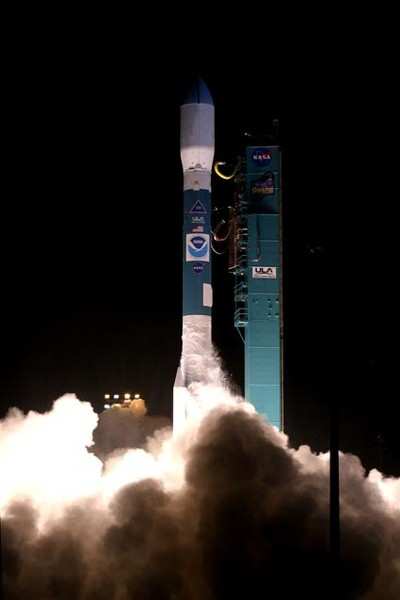Fri, Feb 06, 2009
Weather Research Station Joins Two Others In Polar Orbit
The third time WAS the charm for NASA and the National Oceanic
and Atmospheric Association. The Delta II booster carrying the
NOAA-N Prime research satellite lifted off early Friday morning
from Space Launch Complex-2 at Vandenberg Air Force Base in
California.

The countdown proceeded smoothly throughout the night, and up to
T-minus zero at 2:22 am Pacific time. Neither the spacecraft nor
the United Launch Alliance Delta II launch vehicle experienced any
technical issues, and the weather conditions remained
favorable.
NOAA-N Prime -- also known as NOAA-19 -- joins NOAA-18 and one
European environmental satellite already in polar orbit. NOAA-Prime
carries seven scientific instruments, including two search and
rescue instruments and a data recording system.
Unique with this satellite is a new data collection system that
will relay meteorological, oceanographic data – even track
migration patterns of wildlife – to help researchers improve
their study of Earth’s environment.
Data from NOAA-19 will support several NOAA programs, including
weather analysis and forecasting, climate research, and detection
of forest fires and volcanic eruptions.
NOAA operates two types of satellite systems for the United
States -- geostationary and polar-orbiting. Geostationary
satellites constantly monitor the Western Hemisphere from around
22,240 miles above the Earth, and polar-orbiting satellites circle
the Earth providing global information from approximately 540 miles
above the Earth.
As ANN reported, the first targeted launch
attempt Wednesday was scrubbed, when a launch pad gaseous nitrogen
pressurization system failed. Engineers commenced immediate repairs
to that system, in hopes of launching the satellite Thursday... but
then a pad-mounted air conditioning compressor, which supplies
cold, dry air under the payload fairing surrounding the sensitive
satellite, also failed.
More News
Pilot Also Reported That Due To A Fuel Leak, The Auxiliary Fuel Tanks Were Not Used On June 4, 2025, at 13:41 eastern daylight time, a Piper PA-23, N2109P, was substantially damage>[...]
Have A Story That NEEDS To Be Featured On Aero-News? Here’s How To Submit A Story To Our Team Some of the greatest new stories ANN has ever covered have been submitted by our>[...]
From 2023 (YouTube Edition): Reflections on War’s Collective Lessons and Cyclical Nature The exigencies of war ought be colorblind. Inane social-constructs the likes of racis>[...]
Aero Linx: Colorado Pilots Association (CPA) Colorado Pilots Association was incorporated as a Colorado Nonprofit Corporation in 1972. It is a statewide organization with over 700 >[...]
High Speed Taxiway A long radius taxiway designed and provided with lighting or marking to define the path of aircraft, traveling at high speed (up to 60 knots), from the runway ce>[...]
 NTSB Prelim: Piper PA-23
NTSB Prelim: Piper PA-23 ANN FAQ: Submit a News Story!
ANN FAQ: Submit a News Story! Classic Aero-TV: One Mans Vietnam
Classic Aero-TV: One Mans Vietnam ANN's Daily Aero-Linx (07.03.25)
ANN's Daily Aero-Linx (07.03.25) ANN's Daily Aero-Term (07.03.25): High Speed Taxiway
ANN's Daily Aero-Term (07.03.25): High Speed Taxiway



